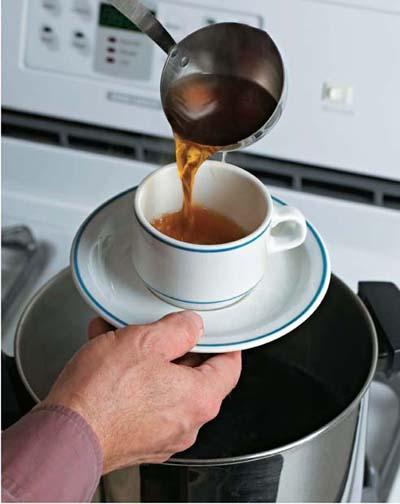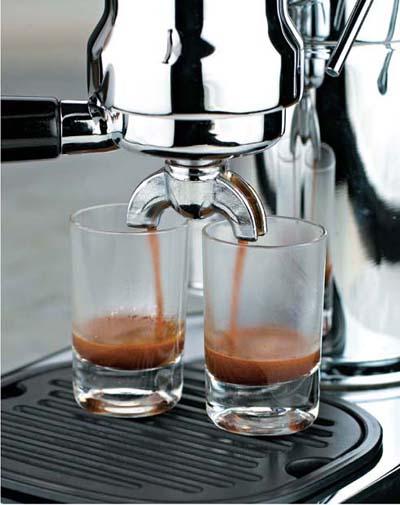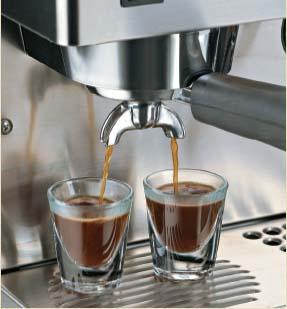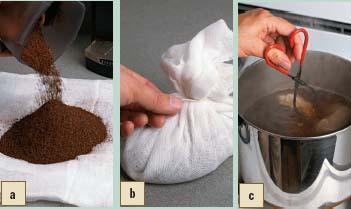The Art and Craft of Coffee (20 page)
Read The Art and Craft of Coffee Online
Authors: Kevin Sinnott

5. Once the coffee stops boiling, repeat the process, bringing it to a boil twice more, reducing heat immediately upon boiling.
6. As it reaches a boil its third and final time (and likely, as the foam nears the top of the ibrik’s neck, in spite of our precautions), remove the ibrik from the heat.
7. Pour carefully into prewarmed demitasse cups. Divide the foam between the cups using a spoon.
Ibrik/Turkish/Greek Method Tutorial

Open Pot/Cowboy/Campfire Coffee
Open pot coffee means boiling or almost-boiling water and tossing in grounds. This is coffee brewing at its most basic. It requires nothing but a pan (and coffee and water, of course). It’s good for making large batches of coffee. At one time, a church that wanted to make coffee for its social used this method.
Materials
Pan, deep enough to hold a decent amount of water with no overflow risk
21/2 gallons (9.5 L) water
Stovetop or other heat source
1 pound (455 g) whole bean coffee, 2 tablespoons (10 g) per 6 ounces (180 ml) water
Grinder set to coarse
Filter bag (made from any kind of tight weave, such as a sock or a sugar sack)
String, to tie filter bag closed
Timer
CAN’T HANDLE THE SOCK?
If the thought of using a sock turns your stomach, don’t use one. Instead, put the grinds directly into the water and at the eight-minute mark, just after removing pan from heat, use a strainer to remove them.
< Open pot coffee is boiled in the stovetop and served with a ladle.
Instructions
1. Measure and fill open the pan with water.
2. Place on high heat. Once the water boils, lower the heat to bring it just under boiling, recognizable by pea-sized bubbles.
3. Grind the coffee beans. Use 2 tablespoons (10 g) of coffee per 6 ounces (180 ml) of water. For large crowds, use 1 pound (455 g) of coffee to 21?2 gallons (9.5 L) of water.
4. Place the grounds into a filter
(a)
. Tie a string around the filter but leave plenty of room for the grounds to swell
(b)
.
5. Shut off the heat. Drop the grounds into the water and begin timing.
6. After 10 to 15 minutes, remove the filter
(c)
and serve the coffee with a ladle.
Open Pot/Cowboy/Campfire Tutorial

6 ESPRESSO
ESPRESSO
is a highly concentrated coffee drink, the basis of a litany of beverages found in cafés all around the world. Some people mispronounce it “ex-presso”—an almost intuitive mistake considering the quick process to make the drink.
Making espresso requires a dedicated espresso machine, most of which consist of a chassis with a boiler. Once the water gets hot enough, a pump allows it to flow into a metal device called a head or group, which contains packed grounds. The pressure from the machine then forces the water through the grounds, extracting the precious coffee oils in seconds. The liquid coffee excretes through a bottom spout in the head.
Normally, espresso is served in one-or two-ounce (30 or 60 ml) amounts depending on the machine’s head or group size. The industry refers to espresso in one-ounce (30 ml) form as a shot. So when a customer requests a triple-shot espresso, assume the order calls for three ounces (90 ml) of espresso.
Although some consider espresso the strongest-tasting coffee (see “Ibrik,”
chapter 5
, page 121, for a counter-argument), paradoxically, it has the lowest caffeine content by serving (though not volume). People who claim to be “high” on espresso after drinking a shot or two may be experiencing what’s known as the placebo effect—they think the espresso’s caffeine will affect them, so it does. Perhaps the fact that it’s easy to drink a high volume of espresso, especially when it’s buried in mounds of froth and made from higher caffeine Robusta coffee beans, might offer an explanation.
In this chapter, you will learn the following:
• What factors go into making the perfect espresso
• How to select the appropriate grind for your espresso maker
• What extraction time, tamping pressure, and espresso bitterness mean
• How to differentiate and select an espresso maker
• How to pull the perfect espresso shot
< The espresso was invented for its brevity, but has stayed due to its powerful taste and versatility. Here is a perfect espresso shot in the making, showing off its twin “mouse’s tail” drips.
The History and Science of Espresso
Italy’s communist government originally embraced espresso as an attempt to shorten the world-renowned Italian coffee break. Giovanni Achille Gaggia actually invented espresso. In his Milan coffee shop, Gaggia patented a piston, which he attached to existing coffee brewing machines to try to reduce the coffee’s bitterness. In 1947, after eight years, he succeeded.
In many ways, it was the most significant coffee-brewing development of the modern age. In the 1960s, espresso took off around the world, as American tourists tasted the drink in Italy and brought it home, and films started showing movie stars drinking it.
For home aficionados, espresso is complex and anything but efficient. But to its fans, it is the holy grail of coffee preparation, a coffee obsessive’s dream hobby. It has all the maddening, glorifying manic-depressive experience of a great love affair. Espresso mastery demonstrates the hobbyist’s expertise (and madness) to friends and relatives. Part of espresso’s allure is, no doubt, its preparation. With practice and skill, you’ll get better at making espresso. One day, your espresso machine may even become your first choice.
Most coffee-making methods depend on gravity or steeping, but espresso is a high-pressure extraction method, which means you can produce a strong-tasting beverage quickly. Small variations in grind fineness, timing, or water pressure result in significant flavor differences. Serious espresso hobbyists thoroughly research their process. They want to know the pressure (measured in bars—the higher the number, the greater the pressure) and water temperature. If a drip machine takes thirty seconds to reach ideal brew temperature, it won’t ruin the cup; thirty seconds is the
total
brewing time for an espresso.
What Defines a Great Espresso?
You must consider many factors when attempting to create a great espresso.
Grind
Nearly everything comes down to the grind with espresso. No two espresso machines or grinders are perfectly alike. I cannot stress enough the importance of matching the correct grind with a given machine. Preground coffee is especially problematic for home espresso making. Though preground is usually fresh enough for home drip methods, it will likely never be fresh enough for espresso and will almost certainly result in a lackluster shot. (See the section later in the chapter on page 136 about selecting the appropriate grind for your espresso machine.)
Each day, check and calibrate the espresso’s grind before making consumable shots. Humidity variation from one day to the next affects espresso. Also, if the grind is too coarse, the water will flow through the head too quickly, resulting in a weak, thin shot. If it’s too fine, the water will flow too slowly through the head, and a bitter, thick coffee will result. At each session, try different grind settings to discover which creates the perfect grind consistency for your machine.
Taste
Espresso tastes distinct from other coffee brewing methods. It is so different that it often benefits from its own blends and roasts. Also, because of its on-site creation moments before serving, rather than sitting for hours on a burner, it’s guaranteed to taste fresh.
A well-made espresso shot should taste almost tangy. It is definitely more bitter than traditional filtered coffee, so expect some bitterness. Most consumers do not drink straight espresso, but they drink latte beverages that contain espresso. The sweetness of the milk in these drinks nicely offsets any bitterness.

If the grind is too coarse, the espresso shot flows too fast.
Connoisseurs who do have straight espresso limit their bitterness by drinking blended espressos or origin coffees such as Brazil’s and carefully optimizing the brewing process. Of course, you want a little bitterness, but not too much. Espresso mavens claim that they can deliver smooth, silky, and even sweet shots. If you only drink properly made drip coffee, your first espresso may be a shock, especially if you expect sweetness.


